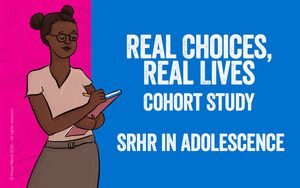SRHR in Adolescence (2022)
Insights from the Real Choices, Real Lives Cohort Study

Data has been collected on the Real Choice Real Lives study for 14 years, a study which tracks the lives of girls and their families in nine countries around the world. This unique longitudinal and qualitative study offers valuable insights into the life cycle of girls and the choices, decisions and realities that shape their lives. The study aims to uncover how gendered social norms and behaviours are created and sustained or shift over time.
This year’s report focusses on sexual and reproductive health and rights (SRHR). The girls on the study are now entering late adolescence. A particularly vulnerable time where gendered expectations become more pronounced particularly in relation to girls’ SRHR.
Full Report (English)
8.22 mb
Executive Summary (English)
1.44 mb
You may download French and Spanish versions of the report and executive summary at the bottom of this page.
Key findings
A girl’s age and menarche are key entry points for SRHR dialogue with caregivers
Menarche (the first occurrence of menstruation) is seen by caregivers as marking an immediate shift from girl to woman. Menarche continues to be a key turning point for caregivers to begin to communicate on SRHR, but it also marks a moment when caregivers believe they have to strictly manage girls’ sexuality and behaviour.
Risk mitigation is prioritised over sexual wellbeing
Rigid cultural and gender norms prioritise SRH education at home and at school as solely a means to avoid pregnancy and violence, effectively excluding any discussion of girls’ sexual wellbeing. A high value is placed on abstinence and advice shared puts the onus on the girl to protect herself from unintended pregnancies, and even rape and other forms of sexual violence.
Social and gender norms influence caregiver dialogue around SRHR and gender-based violence
Our analysis shows that norms are perpetuated through shared social expectations of how girls should behave in relation to their SRHR. These are also actively enforced through monitoring of girls’ expected behaviours and through social sanctions of shame and taboo when girls transgress these expectations.
Social and gender norms continue to be a key influence on caregiver– adolescent communication around SRHR and caregivers have conservative attitudes in relation to girls’ SRH. Male caregivers are excluded from girls’ SRHR education and struggle to navigate gender norms that discourage their involvement in dialogue with adolescents about their SRH. Throughout the girls’ life course these social and gender norms evolve to become more rigid and as girls enter into later adolescence they are monitored more closely.
Intergenerational experiences are a key influence for caregivers
Caregivers’ own life experiences, particularly around early marriage and pregnancy, often influence the approaches they take on SRHR. Despite expressing negative associations with their own experiences of SRHR as adolescents, female caregivers face difficulties in changing the narrative communicated to girls about their bodies and sexuality.
Caregivers and girls feel ill-equipped to talk about SRHR
The absence of detailed meaningful conversations around SRHR both at school and at home leaves girls uninformed and ill-equipped to deal with their own sexual and reproductive health, which often leaves them more vulnerable to unintended pregnancies, early marriages and unions, and gender-based violence.
A starting point for improving adolescent girls’ SRHR is an enabling policy environment, but this needs to coincide with normalising open and honest discussions about sexual and reproductive health both in the formal and non-formal education settings and in community discourse. Read our report and executive summary below.
Download other languages
Full Report (French)
8.33 mb
Executive Summary (French)
1.43 mb
Full Report (Spanish)
8.35 mb
Executive Summary (Spanish)
1.46 mb


